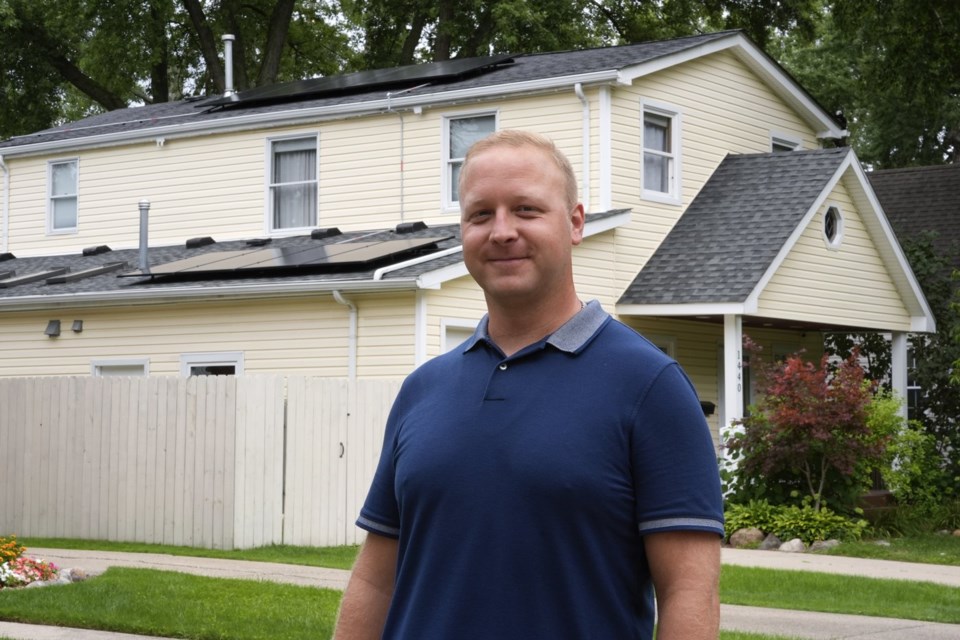Software engineer Kenna Ofoegbu in Houston, Texas tries hard to keep his three kids cool during and that means air conditioning.
Yet their house has lost power three times in just the past two and a half months. One of those outages lasted three days.
That time, Ofoegbu and his wife decided to pay for two nights at a hotel, both for the air conditioning and the connectivity.
“I could not afford to go multiple days without having internet connection," the 42-year-old said. “Having power and internet access is critical to my daily work.”
When that ordeal was over, the couple did what many do if they can afford it: They bought a generator. It cost $1,500 plus some $800 for an electrician to do some wiring, and burns either propane or gasoline to keep the house running.
But burning those fuels can make the air foul to breathe and also worsens climate change, prompting Ofoegbu and many others to seek cleaner ways to maintain electricity in an emergency.
So far, the options are mostly expensive but they are improving. Here's the current state of play:
Many people are now installing arrays of batteries at their homes. As of April, more than half of rooftop solar buyers in California chose to install batteries with their so that when the grid goes down, the house doesn’t. Nationally, sales of these solar-plus-battery systems , according to Wood Mackenzie, a consulting firm.
They expect 27% of new home solar systems in the U.S. this year to be paired with storage, almost doubling the share of buyers, 14%, that chose this option last year. These systems easily cost thousands of dollars, but solar and battery prices have fallen, bringing them within reach of more people. Government incentives help, too.
On the portable side, “solar generators” and boxes known as solar power stations are becoming more popular. They are not truly generators because they do not generate electricity, instead they store it for when it's needed. Users have to prioritize certain devices or appliances during an outage, to avoid draining the battery.
One, called the “Patriot Generator,” and marketed on 4Patriots.com, costs about $2,500. It holds enough energy to run a refrigerator for 19 hours, medical devices for 15 hours or personal electronics for over 100 hours.
The companies Yeti, Bluetti and Jackery also sell these power stations — basically larger versions of the power banks people use to keep phones charged on the go. Weighing around 40 to 60 pounds, they recharge by plugging in or from the sun.
“A lot of people start with a power station of that size, and they might use it for camping, they might use it for recreation, tailgating,” said , North America head of business development at EcoFlow, which also designs products that can be used for recreational vehicles and homes that are not connected to the grid. “I could plug probably a couple of deep freezers and a refrigerator into this, and it would run it for a day plus."
Increasing demand
The number of days when people need these backup solutions is growing as human-caused climate change intensifies and strain , experts say.
The average person in the U.S. experienced 16% more disruptions in 2022 than in 2013, according to the from the Energy Information Administration. On average, it took about four hours to bring power back online in 2022, one hour longer than in 2013, the agency reported.
caused by major events last longer than 12 hours, and more than a third last longer than a day, according to the National Renewable Energy Laboratory.
That translates to more days when outdoor air is affected by people firing up their generators. Days of record-breaking heat for example, when demand for air conditioning can bring on blackouts, are often bad air days.
“If we are talking about the heat waves, that’s almost guaranteed high ozone,” which is harmful to people’s health, said Max Zhang, an engineering professor at Cornell University. Hot days are when "you’ll see the worst impact of diesel generator emissions,” he said.
Diesel particle pollution, or soot, is also a carcinogen. Diesel and gasoline-burning generators emit nitrogen oxides as well, which can trigger asthma. They also let off planet-warming carbon dioxide.
Jason Benedict moved to Berkley, Michigan, a suburb north of Detroit, from Oregon in 2020. He’s already gone through several outages in his new state.
The were the worst. He lost power for over 5 days and had to throw away food. He tried to keep part of one room warm enough for himself and his dog, then ended up leaving his house to stay with family nearby. The power came back on, only for weather to take it down again for another two days.
Benedict, 38 and an accountant, wanted something cleaner than the machines he heard chugging in his neighborhood, “these gas generators running all day, every day.” So late last year, he spent about $25,000 for solar on his roof plus a Tesla Powerwall battery in the garage.
“Knowing that it’s really not an issue is completely worth it,” he said.
Diesel, propane and gasoline generators still rule. They’re “extremely cost effective and robust,” said Jeffrey Marqusee, NREL senior research advisor, emeritus. But they “are not the perfect solution that people think they are for the future we’re facing.
“That’s not the world anymore.”
___
Alexa St. John is an Associated Press climate solutions reporter. Follow her on X, formerly Twitter, . Reach her at [email protected].
___
The Associated Press’ climate and environmental coverage receives financial support from multiple private foundations. AP is solely responsible for all content. Find AP’s for working with philanthropies, a list of supporters and funded coverage areas at .
Alexa St. John, The Associated Press




